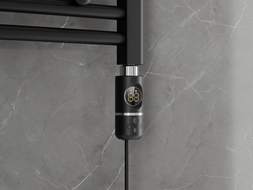
Products such as concealed mixers are an essential element of a modern bathroom. They consist of components mounted on the wall to which cold and hot water is connected. This part is hidden behind the wall. However, on the outside, you can only see the surface-mounted module consisting of a handle, switches, and a rosette. It is an excellent solution for any minimalist interiors. Concealed mixers allow for saving a lot of space, do not attract attention, and subtly emphasize the class of the room.
Advantages of the built-in tub system
Above all, what convinces homeowners to choose such a solution is aesthetics. The built-in tub system has a modern appearance, and all connections remain invisible to the eye. The entire module responsible for the functionality of such a system is hidden in the wall, while the surface-mounted module usually has simple, minimalist shapes, making it easy to keep clean. Moreover, the built-in tub system gives the bathroom a new, modern design. Despite the fact that the concealed system is hidden, it is easily accessible. You can easily access it by unscrewing the outer handle and the rosette.
You can also connect a tub spout or a rain shower to the concealed shower system, but such a solution is not possible in all models. When deciding to purchase, it is worth paying attention to the flow class. The larger it is, the more different additional modules can be connected, and the greater the functionality of the bathroom. This functionality is the biggest advantage of the built-in tub system. Manufacturers offer various options, often featuring a thermostat, which greatly increases the comfort of bathing. Moreover, concealed systems as elements of plumbing have high-quality heads, which means that the flow of water is greater.
How to install the concealed element?
- When starting work, you should first tackle the installation of the concealed element of the mixer.
- If the mixer is to be placed in the middle of the tub, its height should be about 80 cm - in the case of a tub that is 60 cm high. It is generally assumed that the appropriate height between the mixer and the edge of the tub is about 20 cm, so as to facilitate its use.
- The actual installation begins with making a hole in the wall with a depth allowing for the insertion of the concealed element and convenient access to the water supply pipes. Usually, these pipes have a diameter of 20 mm. They should be placed in grooves, and then connected to the mixer.
- Before plastering the hole, it is worth checking the tightness of all pipes and connections. Users often want to use the tub as a shower, which is why the installation of a rain shower or handheld shower with a hose is so popular (these are incredibly useful accessories).
- Just like in the case of installing the mixer on the wall, you should drill a hole, as well as holes for the pipes supplying water to the rain shower or handheld shower.
- For larger rain shower models with a width of 40 cm, you may need to support it with an additional arm or bracket.
- The rain shower mounted on the wall should be at a height that allows for convenient showering, while ensuring that the water does not splash over the edge of the tub.
Built-in tub system - what height?
When all elements are connected to the concealed module, you should once again check the tightness of the pipes. If the pipes connecting located in the grooves are tight and plastered, you can start laying tiles to hide the water supply pipes. Only at the end of the work is the installation of the surface-mounted element left, which will be visible. Most often, it is a built-in bathtub mixer with a thermostat, chrome-plated.
The height at which the rain shower or handheld shower will be installed is an individual matter, depending on the height of the household members and comfort. It is generally accepted that the rain shower should be about 30 cm above the height of the tallest household member. Again, there is room for flexibility, because in some cases it is not possible. Bathrooms are too low, and the household members are too tall. Interestingly, rain showers are often equipped with an extension arm. This allows for adjusting the height by about 30 cm.
In the case of ceiling-mounted installation, the rain shower should be located above the central point of the tub. However, this solution is most often chosen for wide and larger tubs. In the case of a too small tub, this option will not yield its results, as water will spill out over the edge of the tub and end up on the floor. For this reason, ceiling rain showers are usually only used in the case of shower cabins.



















